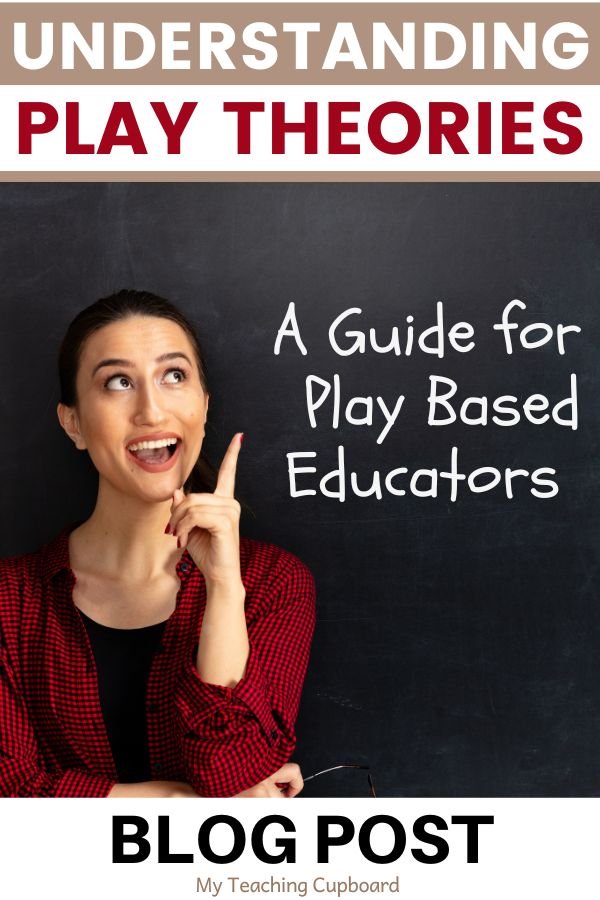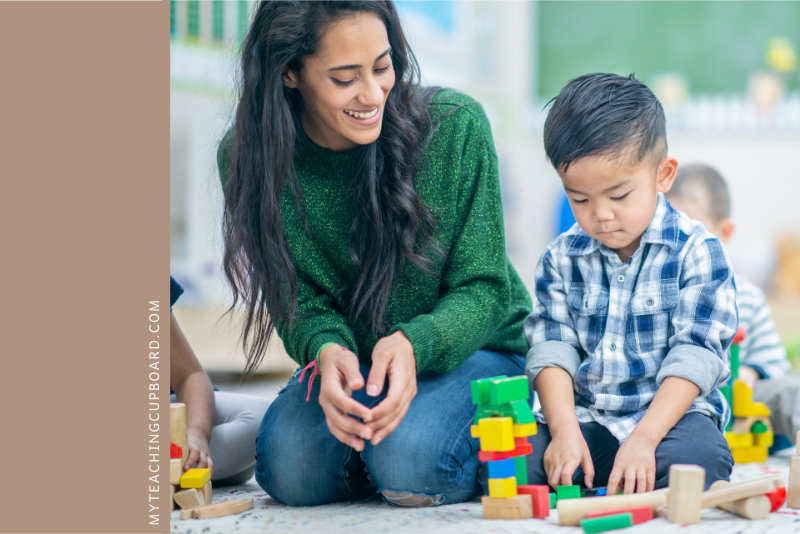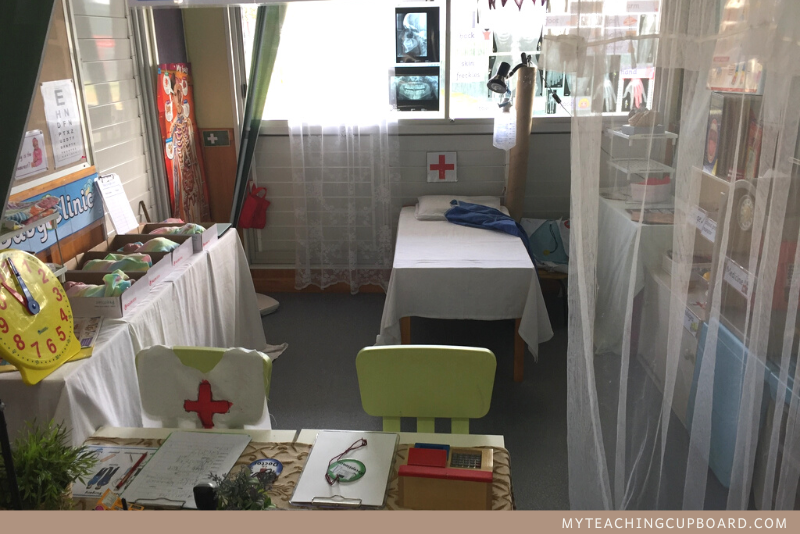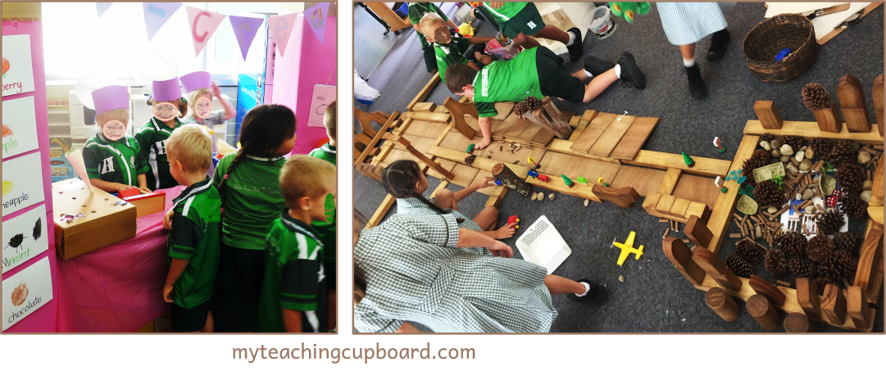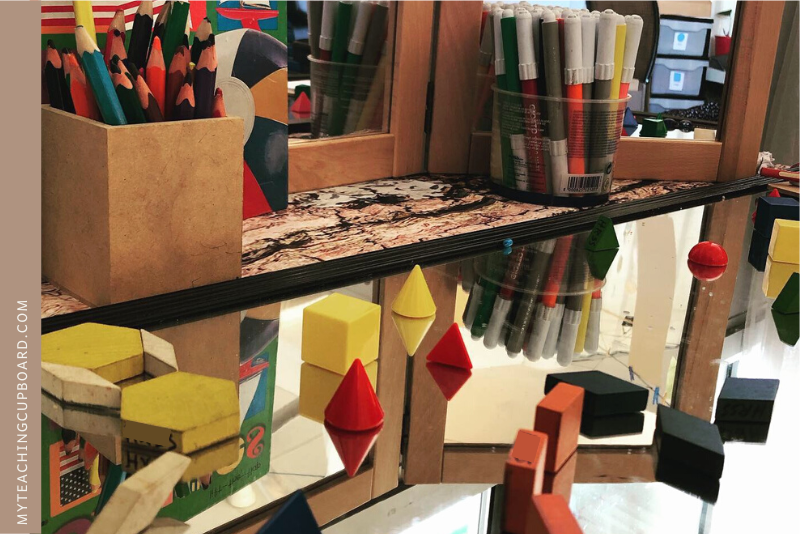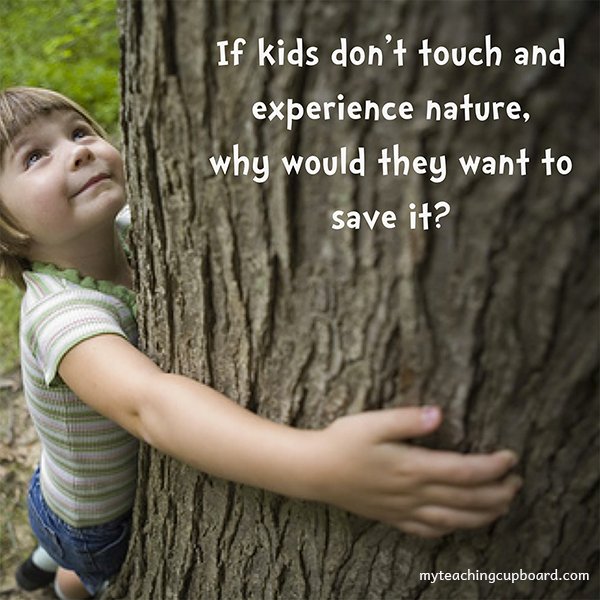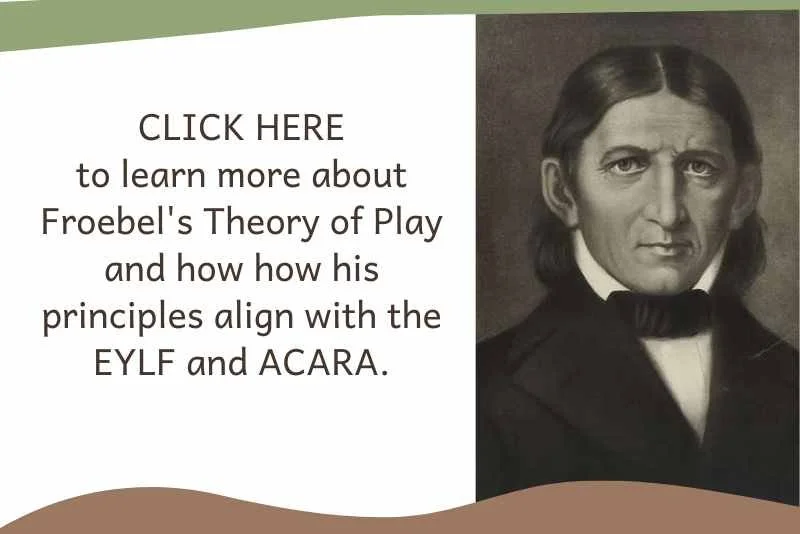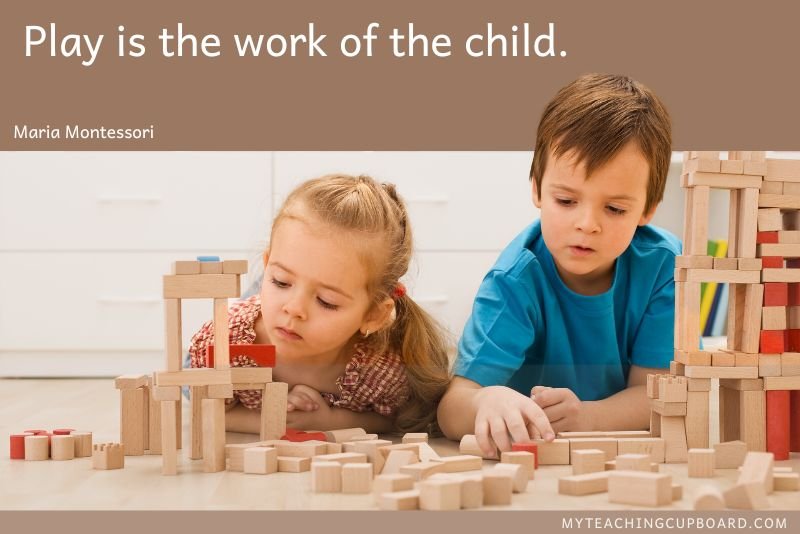Understanding Play Theories: A Guide for Play Based Teachers
Want to learn more about play theories and play based learning? This blog post explores play theories and how they can inform your teaching in the early years classroom.
If you are a play-based teacher like me or interested in implementing playful learning experiences with your students, you need to learn about play theory. The theories on play based learning are going to be the heart and soul of your teaching pedagogy.
The research and theories behind play-based learning confirm the belief that play is not just a childhood pastime. Play is a powerful tool and the best way for children to learn. Gaining an understanding of play theories will help you transform the way you teach.
Oh, the wonders of play!
As an experienced play-based teacher, I am very aware of the amazing benefits it brings to my students. Play really is the gateway to cognitive growth, learning social skills, emotional well-being, and physical development. Through play, children can express themselves, connect with others, and make sense of their world.
So if you are an early childhood educator, you should learn as much as you can about the theory of play and the developmental stages of play.
An Overview of 8 Key Play Theories
There are numerous play theories we could explore in this blog post. There are so many that a discussion on play theories could easily fill a book 9or a library). We are going to look at the theories most relevant to the early childhood classroom and for children aged between 4 and 8 years.
1. Piaget's Cognitive Development Theory
Jean Piaget's insights into cognitive development align perfectly with a play-based learning classroom. His stages of development can inform the diverse play experiences you create in your classroom. By learning about Piaget's theory, you will be able to provide appropriate play opportunities that engage your students and align with their cognitive development.
Jean Piaget (1896–1980) was a Swiss psychologist that believed children take an active role in the learning process. He is one of the most influential theorists in the field of child development and play. According to Piaget, there are four distinct stages of cognitive development:
Sensorimotor stage (birth to 2 years): During this stage, infants learn about the world through their senses and motor actions. They develop object permanence or the understanding that objects continue to exist even when they are out of sight.
Preoperational stage (ages 2 to 7): Children in this stage start to use symbols and language to represent objects and events. This is when symbolic play and drawings emerge. Their thinking is egocentric and lacks the ability for concrete logical reasoning.
Concrete operational stage (ages 7 to 11): At this stage, children become capable of concrete logical thought and can understand conservation, reversibility, and cause-and-effect relationships.
Formal operational stage (ages 12 and up): In this final stage, adolescents can think abstractly, reason hypothetically, and engage in complex problem-solving.
Piaget's theory has significant implications for play-based learning approaches in early childhood education. We know play is a natural way for children to explore and make sense of the world around them and here’s how Piaget's theory supports that:
Importance of Active Learning
Piaget found that children learn by actively engaging with their environment. Hands-on exploration is at the heart of play-based learning in the classroom and according to Piaget’s theories, this type of active learning is ideal for cognitive development.
Role of Assimilation and Accommodation
Piaget also proposed that children assimilate new information into existing mental structures or schemas. Play allows children to experiment and adapt their understanding of the world by either assimilating new experiences into existing knowledge or creating new schemas to accommodate novel situations.
Support for Different Stages
Play-based learning can be designed to suit the cognitive needs of children at all different stages of development. As teachers, you are well aware that not every child in a kindergarten classroom is going to be working at a kindergarten level or that every child learns best by sitting and listening to a teacher. For example, sensory play may be more suitable for children in the sensorimotor stage, while pretend play might be more suited to children in the preoperational stage.
Social Interaction and Cooperative Play
Piaget recognised the significance of social interaction in cognitive development. Play-based learning provides so many opportunities for children to develop their communication and language skills. When children have the opportunity for cooperative play experiences, they will build their oral language, learn to negotiate, and begin to understand others’ perspectives.
Building on Prior Knowledge
Play-based learning allows educators to build on children's prior knowledge and interests. By incorporating familiar themes into play activities, you can create active learning experiences that help children connect new concepts with what they already know.
Supporting Creativity and Imagination
Pretend play, a staple in any play-based classroom, stimulates creativity and imagination in children. It allows them to experiment with various roles and scenarios. This all helps develop a child’s cognitive flexibility and divergent thinking skills.
Piaget's cognitive development theory highlights the critical role of play in children's learning and cognitive growth. Play-based learning provides a developmentally appropriate approach to education. It fosters a deeper understanding of concepts and promotes active engagement in the learning process.
If you want to learn more about Piaget and his cognitive development theory, you should check out this blog post: Stages of Development - Piaget
2. Vygotsky's Socio-Cultural Theory
Lev Vygotsky (1896-1934) was a Russian psychologist who focused on the importance of social interaction and cultural context in a child's cognitive development. Unlike Piaget, Vygotsky believed that learning and cognitive growth are deeply influenced by the people and culture surrounding a child.
Vygotsky’s play theory highlights the significance of the Zone of Proximal Development (ZPD) and the role of more knowledgeable others (MKOs) in scaffolding a child's learning.
His theory emphasised the role of social interactions in learning. As a play-based teacher, you no doubt encourage collaborative play. According to Vygotsky, this is where the magic happens. Here's an overview of Vygotsky's theory and its implications for play-based learning:
Zone of Proximal Development (ZPD)
Vygotsky introduced the concept of the Zone of Proximal Development. This zone is about the difference between what a child can do independently and what they can achieve with the guidance and support of a more skilled individual.
Play-based learning can be tailored to a child's Zone of Proximal Development by providing learning experiences that are just beyond their current level of competence but are still attainable with assistance. It’s a tricky task for a beginning teacher – I know! I also want to let you know that it becomes easier. With experience, you will be able to design learning provocations that progressively build a child’s skills and knowledge.
Scaffolding Play
Scaffolding refers to the support provided by a more knowledgeable other (a teacher or a peer) to help a child accomplish tasks within their Zone of Proximal Development. In play-based learning, teachers and other classroom members can act as scaffolds for learning. You can scaffold the learning by offering guidance, asking open-ended questions, and encouraging critical thinking. Through this scaffolding, your students will develop higher-order thinking and problem-solving skills.
Cultural Tools and Artifacts in Play
Vygotsky emphasised the role of cultural tools, like language, writing, and technology, in shaping a child's cognition. Try to include cultural artifacts and communication tools in your learning provocations. Give your students opportunities to explore and understand their cultural heritage in your play-based learning environment. It is important that you offer opportunities for your children to use many ways to communicate and express themselves.
Collaborative Learning
Vygotsky's theory highlights the value of collaborative learning experiences. Play-based learning is all over this! Collaboration and group activities where children work together, share ideas, and learn from one another are common in a play-based classroom. This type of cooperative play nurtures social skills, empathy, and a sense of community.
Private Speech in Play
Vygotsky observed that children often use private speech (talking to themselves) during play or problem-solving tasks. This self-talk helps children regulate their thinking and actions. Play-based learning environments should recognise and encourage thinking aloud and private speech. It really does help a children's cognitive self-regulation.
Make-Believe Play
Vygotsky’s theory suggests make-believe or pretend play is very important in a child's development. Imaginative or dramatic play gives children the opportunity to take on different roles and act out different scenarios. The imagination, creativity, and the exploration of social roles and situations will all be developed through this type of play.
Continuous Development of Play
Vygotsky's theory suggests that development is a continuous process influenced by social and cultural factors. With this in mind, play-based learning should provide ongoing opportunities for children to engage in activities that align with their changing developmental needs and interests.
Vygotsky's development theory supports the inclusion of opportunities for social interaction, cultural context, and collaborative learning in a child's cognitive growth. A play-based learning environment is perfect for supporting these principles. It will provide a rich and supportive environment that nurtures children's development, fosters creativity, and helps learners thrive both intellectually and socially.
3. Erikson's Psychosocial Development Theory
Erik Erikson (1902-1994) was a German-American psychoanalyst known for his Psychosocial Development Theory. This theory focuses on the social and emotional aspects of human development across the entire lifespan. Unlike other theorists who primarily focused on childhood, Erikson's theory extends from infancy right through to old age.
His theory outlines eight stages, and each stage is characterized by a unique psychosocial crisis. His theory can remind play-based teachers of the emotional and social aspects of child development. Through play, children can explore emotions, build self-esteem, and develop strong identities.
Let’s look at the stages relevant to childhood:
Trust vs. Mistrust (Infancy - 0 to 1 year): During this stage, infants learn to trust or mistrust their caregivers based on the consistency and responsiveness of their care.
Autonomy vs. Shame and Doubt (Toddlerhood - 1 to 3 years): Toddlers begin asserting their independence and exploring the world in this stage. Play-based learning should encourage opportunities for safe exploration and decision-making, allowing children to develop a sense of autonomy and self-confidence.
Initiative vs. Guilt (Preschool - 3 to 6 years): Preschoolers start taking initiative in their play and other activities. In a play-based learning environment, children should be given opportunities for imaginative and creative play to develop their initiative and problem-solving skills.
Encouraging children to initiate their own play and express their ideas will help to build a sense of autonomy and self-confidence. Positive reinforcement and encouragement during play activities are important according to Erikson's theory because they can help to prevent excessive guilt.
Industry vs. Inferiority (School Age - 6 to 12 years): As children enter primary school, they become more focused on mastering tasks and skills. Play-based learning activities that involve collaboration, teamwork, and skill development can all help children develop a sense of competence and industry at this stage. Encouraging your students to tackle new tasks and supporting their efforts to succeed will also help to build their self-esteem and motivation to learn.
In the later primary school years, children begin to explore their identities and roles within their social groups. Play-based learning should include activities that allow children to express themselves, explore their interests, and collaborate with others. It is suggested that group projects, drama, and storytelling can help them develop a cohesive sense of identity and build meaningful social connections.
The focus of this blog post is on children aged 4 to 8 years. Play-based learning for this age group should focus on nurturing curiosity, creativity, and social skills. It should also include a mix of individual and group activities that encourage exploration, problem-solving, and self-expression.
Play-based learning environments that offer a balance of structured and unstructured play will help to develop critical thinking, emotional intelligence, and a positive self-concept according to Erikson's Psychosocial Development Theory.
4. Froebel's Play Theory
Friedrich Froebel (1782-1852) was a German educator who is often regarded as the pioneer of the kindergarten movement. He developed the concept of play as a fundamental element of early childhood education and established the idea of a kindergarten or a garden of children.
Froebel's Play Theory suggests that play is the natural and essential activity of young children, and it serves as the primary means through which they explore and understand the world around them. Now you know why I have included this theory in this blog post. Here are the key aspects of Froebel's Play Theory and its implications for play-based learning classrooms:
Play as Self-Expression
Froebel believed that play is a form of self-expression for children. He suggested that through play, children can represent their thoughts, emotions, and experiences in a symbolic and creative manner. This is why play-based learning classrooms should provide various materials and opportunities for imaginative play, artistic expression, and storytelling. You need to have a variety of ways children can communicate and make sense of their feelings and ideas.
Play as Developmental Growth
According to Froebel, play is not just a pastime but an essential factor in a child's holistic development. He believed that play supports and builds physical, social, emotional, and cognitive growth. If you follow Froebel’s theory, you will include activities that promote different aspects of development. You would have learning invitations that support gross and fine motor skills, cooperation, emotional regulation, and problem-solving.
Play Materials and Gifts
One of the loveliest of Froebel’s ideas is the concept of play materials as gifts. Froebel’s gifts were specially designed educational toys that promote children's learning and creativity. These materials included geometric shapes, building blocks, and other resources that support children to engage in open-ended play and explore mathematical and spatial concepts.
You can include learning gifts in your classroom too. Include hands-on, open-ended materials that stimulate children's curiosity and encourage exploration and discovery.
Play as Social Interaction
Froebel recognised the social aspect of play and how it supports children's social skills. For this reason, play-based learning classrooms should provide opportunities for cooperative play, group projects, and interactive games. These types of activities will help children learn to share, take turns, negotiate, and work collaboratively. These are all essential skills for social and emotional development.
Nature and Outdoor Play
Froebel saw the importance of nature in children's play and learning. Nature play is a buzzword at the moment and for good reason. Many play-based learning classrooms now incorporate outdoor activities like nature walks and gardening to encourage a much-needed connection with the natural world. Nature-based play will support children's curiosity about the environment and promotes a sense of wonder and care for the planet.
Play as Joyful Learning
Froebel believed that learning should be a joyful and playful experience. This belief is why play-based learning classrooms should create a positive and nurturing environment where children feel safe to explore, take risks, and make mistakes without any fear of judgment. It is so important that you take the time to respect and celebrate each child's unique abilities and interests.
Well, don’t you just love Froebel's Play Theory? It emphasises the central role of play in a child's development and learning. This theory is a good one to learn more about because it supports play-based learning classrooms and has everything to do with creating rich and engaging learning environments for children.
5. Maria Montessori’s Play Theory
Dr Maria Montessori (1870 – 1952) was an Italian physician and educator that created a child-led play pedagogy supported by age-appropriate activities and resources. In a Montessori school, children have the freedom to direct their own learning. They play within very teacher-structured environments.
Maria Montessori is famous for saying that play is the work of the child. For her, play was a platform for children to make active choices and practice various actions or tasks. She placed a strong emphasis on the value of play based on reality. She suggested children use real-life objects to build their understanding of the world.
Maria Montessori also believed that children are intrinsically motivated to learn and that the role of educators is to provide an environment that supports their natural curiosity and drive for discovery. Here are the key aspects of Montessori's play theory and some of its implications for play-based learning:
Purposeful Play
Montessori coined the phrase purposeful play. She observed that children engage in play with a specific goal or intention so for her, play is not just a random or idle activity. Montessori education has the philosophy that play is purposeful and directed towards satisfying the child's developmental needs. To follow this belief, play-based learning classrooms should encourage purposeful play by providing age-appropriate materials that encourage exploration and skill development matched to the child’s developmental needs.
Teacher Constructed and Prepared Environment
Montessori believed in creating a carefully prepared environment that children can explore and learn independently. Montessori-inspired classrooms would be equipped with a variety of specifically designed hands-on materials and teacher-created activities that cater to each children's developmental stages and interests. The materials are organised and easily accessible in these classrooms and allow children to choose activities that capture their curiosity and challenge their abilities.
Child-Centred Learning
Montessori's play theory emphasises the importance of allowing children to take the lead in their learning. In a play-based learning classroom, you would act as a facilitator of the learning. Your role would include observing and supporting children's developmental interests and needs. Self-directed learning and autonomy would be encouraged.
Sensory Exploration
Montessori saw the significance of sensory experiences in a child's cognitive development. In a play-based learning environment, there should be opportunities for sensory exploration through tactile materials, nature-based activities, and sensory play.
Mixed-Age Groupings
Montessori classrooms usually have mixed-age groupings where children of different ages learn together. According to Montessori, this arrangement promotes peer learning, collaboration, and a sense of community. Many play-based learning classrooms can also have mixed-age groups. I have taught in multi-age classrooms, and I really enjoyed how the younger children would learn from older ones. The older children could also reinforce their learning by teaching and guiding their younger peers.
Freedom Within Limits
Montessori's play theory advocates for providing children with freedom within limits. While children have the freedom to choose their activities and explore at their pace, the learning environment has clear boundaries and guidelines. Boundaries and guidelines are important in every classroom and not just in play-based learning classrooms. The idea of offering children freedom of choice within a structured framework is necessary to ensure safety and respect for others.
Joy of Learning
Montessori strongly supported the idea that learning should be a joyful and self-rewarding experience. Therefore, in play-based learning classrooms, the focus should be on intrinsic motivation and fostering a love for learning that comes from within. If you can encourage a positive attitude towards exploration and discovery, it can help your students become lifelong learners.
Maria Montessori's play theory promotes a child-centred approach to education. Purposeful play, sensory exploration, and freedom within limits are all important takeaways that we can apply to our play-based learning classrooms. We can use her principles to design learning environments that spark children's natural curiosity and foster their independence.
6. Susan Isaac’s Play Theory
Susan Isaacs (1885-1948) was a prominent British psychoanalyst that built her theory around the work of Froebel and Montessori. She believed that play was extremely important for both cognitive and emotional development. Isaac believed that play provides a safe space for children to explore and express their feelings and emotions, and through play, children can engage in active learning and become comfortable with their skills and abilities.
Isaacs believed that play is a window into a child's inner world and that it should be respected, understood, and encouraged in every educational setting. Here are the key aspects of Susan Isaacs' approach to play and its implications for teaching in a play-based classroom:
Child-Centred and Child-Led Play
Isaacs advocated for a child-centred approach to play. She suggested that educators should observe and listen to their children in order to understand their interests, needs, and developmental stage. This is important in a play-based classroom too. You should allow children to take the lead in their play and support child-directed activities and exploration. If you follow this approach, you will be respecting the individuality of each child and foster a sense of autonomy and ownership over the learning process.
The Power of Play
Isaacs believed that play is not just a pastime but a powerful learning tool. She suggested that play-based classrooms should have a wide range of play activities which include imaginative play, creative arts, role-playing, and games. These types of activities will develop children's cognitive, emotional, and social development and in turn, promote problem-solving skills, empathy, and emotional expression.
Play as Communication
Isaacs saw play as a form of communication. She said children express their thoughts, emotions, and experiences through play and highlighted the importance of careful teacher observations. In a play-based classroom, you should observe and interpret your student's play to gain insights into their inner world and help you design activities that suit their developmental needs. Isaacs also suggested that play can also be used as a tool to help children express and work through challenging emotions or experiences.
Emotional Well-Being
Isaacs placed a big emphasis on the importance of emotional well-being in a child's learning and development. She suggested that teachers should prioritise creating a safe and supportive environment that allows children to explore and express their feelings through play. In a play based classroom, it is important to encourage open communication and provide emotional support for your students. Isaacs emphasised the need for educators to create a positive and nurturing learning atmosphere.
Play and Learning Integration
Isaacs rejected the notion of play and learning as separate entities. Good on her I say! According to Isaacs, play and learning should be seamlessly integrated. You would need to design play activities with educational goals in mind but prioritise cognitive, social, and emotional learning outcomes.
Role of the Educator
In a play-based classroom that follows Isaac's approach, educators play the role of facilitators and collaborators. They create a rich and stimulating play environment, offer guidance and support when needed, and actively participate in children's play. Teachers would also need to provide opportunities for reflective discussions and encourage students to share their thoughts and ideas about their play experiences.
Susan Isaacs' play theory highlights the value of child-centred and child-led play. She saw play as a powerful and important tool for learning and emotional expression. To implement her theories in your play-based classroom, you would integrate play and learning, respect children's individuality, and create a supportive and enriching environment that nurtures their overall development.
7. Mildred Parten's Stages of Play
There are six stages of play developed by Mildred Parten. Mildred Parten was a sociology professor at the University of Minnesota’s Institute of Child Development. She published a classic study in 1932 on the progressive stages of play development.
Her stages of play can help educators understand how social play changes and develops as children grow. Mildred Parten developed the concept of stages of play to understand how children of different ages engage in play differently and exhibit varying levels of social interaction.
Parten’s stages of play are as follows:
Unoccupied Play: The child observes without participating in the play experience. This is the stage of development where babies or young children make a lot of random movements with their arms, legs, hands, and feet, but they do not engage with others socially.
Solitary Play: The child plays alone and focuses on their activity. In solitary play, a child is usually so absorbed in their own play that they show no interest if other children are nearby and do not bother to approach or socialise with them.
Onlooker Play: The child watches others play without actively joining. Parten found this stage to be most common in children ages two and a half to three years old. In the onlooker stage of play, the child watches and observes other children at play, but there is no direct interaction. This is the first sign that a child shows any interest in socialising. They can be seen observing, asking questions, and making suggestions to others, but they do not directly participate in their play.
Parallel Play: The child plays separately but mimics the actions of others nearby. Parten found this stage was common with children aged around two years old. Parallel play is thought to be one of the first signs of simple social play in young children.
Associative Play: The child is interested in people playing but not necessarily coordinating the play activities. In this play stage, children participate in a common or similar activity but usually have separate goals. While they might interact with each other, there is little actual cooperation. As children grow older, associative play becomes more common. This stage of play teaches children how to get along with others. It teaches cooperation and improves language skills.
Cooperative Play: The child is interested in both people and the organised activity. Role play is common at this stage. The children usually have assigned roles and form a group identity. Associative play and cooperative play are closely related, and sometimes it is difficult to tell them apart. In cooperative play, a child plays in a group organised to produce a product or reach a common goal. There is often a distinct sense of belonging or not belonging among the children in the group. You will notice that usually, only one or two children direct the goal-oriented group activities. Very often, the children share out responsibilities and tasks according to their roles. Cooperative play helps children develop communication skills and advanced organisation skills as they work on a shared objective during play.
According to Parten, social play becomes more obvious as children grow older and improve their verbal communication skills. We can use these play stages to help us understand and plan learning experiences that are aligned with our children's social and cognitive development. Mildred Parton's stages of play provides us with a tool to analyse how social play evolves at different developmental stages.
8. Loris Malaguzzi and the Reggio Emilia Play Theory
Loris Malaguzzi (1920-1994) was an Italian educator and the founder of the Reggio Emilia approach to early childhood education. The Reggio Emilia approach is based on the belief that children are competent and capable learners. It places a strong emphasis on play as a primary vehicle for children's exploration and learning. I love this approach. Here's an overview of Loris Malaguzzi and the Reggio play theory:
Image of the Child
Malaguzzi's Reggio Emilia approach views the child as a curious and competent learner. Children are seen as active constructors of knowledge and capable of expressing their thoughts and ideas in multiple ways. To honour this belief in a play-based learning classroom, educators would see and value children's unique perspectives and abilities. They would provide rich opportunities for their students to explore, question, and create.
Emergent Curriculum
The Reggio Emilia approach promotes an emergent curriculum. This means the curriculum emerges from the interests and experiences of the children. Play is seen as a way for children to explore their interests and ideas. Reggio educators use their observations of children playing to plan and design meaningful learning experiences. In your play-based learning classroom inspired by this approach, you would ensure the curriculum is flexible and responsive and allows your students to take the lead in shaping their learning journey.
Play as a Language
Malaguzzi considered play to be a language that children use to express their thoughts, emotions, and understanding of the world. You may be familiar with the concept of The Hundred Languages of Children. This was Loris Malaguzzi’s way of saying that children have many different ways of expressing themselves and understanding the world. Reggio-inspired learning environments encourage children to engage in various forms of play like dramatic play, art, storytelling, and construction to express themselves. Through these 100 languages of play, children communicate and represent their ideas and thoughts.
The Role of the Environment
The physical environment plays a significant role in the Reggio Emilia approach. The classroom is considered the third teacher, alongside teachers and parents. The space is designed to be aesthetically pleasing, inviting, and flexible. It promotes children's exploration and collaboration. In your play-based learning classroom, you should carefully design an environment and set up learning provocations that spark children's curiosity and encourage open-ended play.
Documentation
The Reggio Emilia approach places great importance on documentation. Reggio teachers observe and document children's play and capture their ideas, interactions, and learning processes. The teacher’s and student’s documentation becomes a tool for reflection. It helps the educators understand their children's developmental stages and interests. Documentation is an important part of a play-based learning classroom too. Teachers should use the documentation to co-construct knowledge and plan new learning experiences with their children.
Collaborative Learning
The Reggio Emilia approach promotes collaborative learning experiences. Children work together on projects and investigations. In a play-based learning environment, encourage your children to participate in group play and projects that support cooperation, communication, and negotiation. Collaborative play is also important for developing social skills and empathy.
Loris Malaguzzi's Reggio play theory values the child as a capable learner and emphasises play as a language for exploration, expression, and communication. In a play-based learning classroom influenced by this approach, educators would create a responsive and stimulating environment, document children's experiences, and encourage collaborative learning.
Why is Play Theory Important for Educators?
Understanding play theory is important for teachers, whether they are interested in implementing a play-based learning environment or not. All children play, and all children learn through play.
Understanding play theories is crucial for implementing effective play-based learning strategies. When play is intentionally integrated into the learning environment and recognised as a powerful tool to support children's growth, creativity, and exploration, you can deliver an age-appropriate and enriching learning experience for your students. By drawing on the insights from play theorists, educators can create a supportive and developmentally appropriate play-based learning environment that maximizes children's learning and overall development.
Here are the key takeaways from this blog post:
Understanding Child Development: Play theories, such as those by Piaget, Vygotsky, Erikson, Froebel, Montessori, Isaac, Parten, and Reggio Emilia, provide valuable insights into how children learn and develop through play. Understanding these theories helps teachers gain a deeper understanding of the cognitive, emotional, and social processes at play during different stages of a child's development.
Informed Curriculum Planning: Play theories can inform your curriculum planning. By highlighting the importance of play in children's learning, teachers can design learning experiences that align with their children's developmental needs. They will e able to provide appropriate play opportunities that stimulate various aspects of their student's growth.
Tailoring Learning Activities: Knowledge of play theories helps teachers to tailor learning activities to suit their student's diverse abilities and interests. Teachers will be able to adapt play-based learning experiences to challenge children at their level of development. When you encounter issues in your classroom (and we all do!), understanding play theory and its role in child development can guide you in troubleshooting and solving those problems.
Effective Teaching Strategies: Play theories offer insights into effective teaching strategies that teachers can use in their classrooms. Strategies like using scaffolding techniques, encouraging cooperative play, facilitating imaginative play, and providing appropriate play materials will maximise children's learning outcomes.
Assessment and Observation: Understanding play theories helps teachers to observe and assess children’s learning and development correctly and effectively. It allows educators to recognise different play behaviours and helps them to understand children's thought processes. It also supports them in the planning process so that they can identify and create opportunities for further support and enrichment.
Supporting Social and Emotional Growth: Play theories help teachers see the importance of play in supporting social and emotional development. Teachers will be able to foster positive relationships, encourage cooperation, and provide emotional support during play to promote children's well-being and social skills.
Communication with Parents and Colleagues: Familiarity with play theories allows teachers to communicate effectively with parents and colleagues about the value of play-based learning. A solid understanding of the theories of play gives teachers valuable insights from well-established theories and can help build support for play-based approaches within the educational community.
Aligning with Pedagogical Approaches: If you follow specific educational philosophies, like those of the Reggio Emilia approach, understanding the theory of play is critical in implementing these approaches effectively.
Professional Development: Knowledge of play theories is essential for every teacher’s ongoing professional development. Learning from research and literature on play-based learning keeps educators informed about current best practices and emerging trends in early childhood education.
A comprehensive understanding of the theory and developmental stages of play is essential for any early childhood educator. If you want to create and deliver engaging, age-appropriate, and effective learning experiences, learn as much as you can on child development and play theories. If you found this guide on play theories useful, other play-based teachers might too. Please consider sharing it…
Just CLICK the sharing box below. 👇

